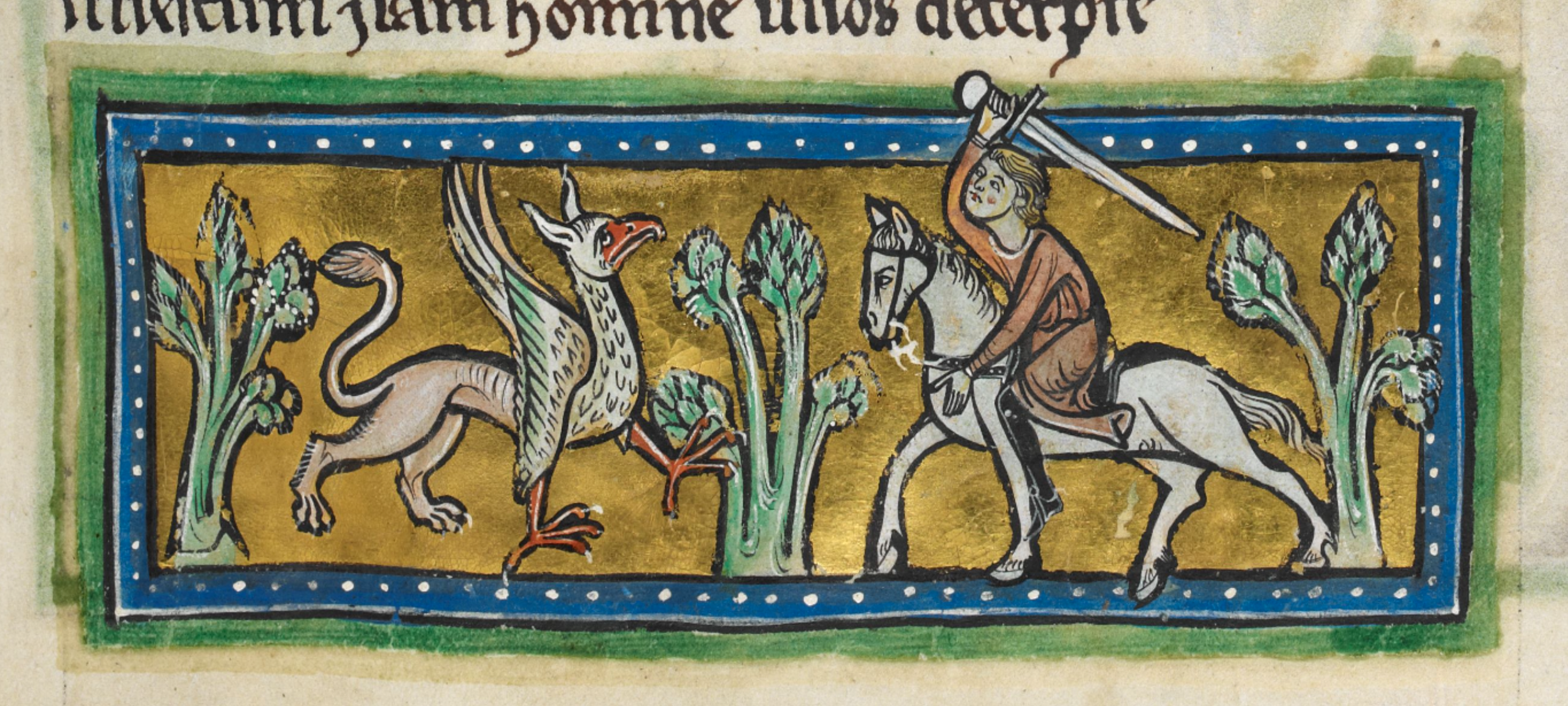Griffin, Rochester Bestiary, c.1230
The griffin is a hybrid creature that combines the features of a lion, the king of beasts, and an eagle, the king of birds. Its hybrid nature symbolised divine and earthly qualities: the eagle represented the spiritual world whereas the lion the material world. In Christian symbolism, the griffin represented Christ: the eagle represented the Resurrection, as eagles were believed to renew their plumage, whereas the lion symbolised Christ’s kingship. The griffin was also the vigilant protector of the Christian faith, representing the need for Christians to defend their beliefs.
et quadrupes; Hoc genus ferarum in yperporeis2
partibus nascitur uel montibus. Omni parte corporis
leoni. Alis et facie; aquilis simile. Equis vehementer
infestum. Nam homines uisos decerpit.
The griffin is a winged animal and a quadruped. This kind of beast is born somewhere on the Hyperborean mountains. In every part of the body, it resembles a lion whereas its wings and face resemble those of an eagle. It is extremely hostile towards horses3 and it tears humans to pieces upon seeing them.
Bibliography
David Badke, The Bestiary Blog: Animals in the Middle Ages, November 6 2023, https://bestiary.ca/beasts.htm
Josh Goldenberg (BA 2012) and Matt Shanahan (BA 2014, Logeion, November 2022, https://logeion.uchicago.edu/
Wikimedia Foundation, Inc., Wikipedia: The Griffin, 28 November 2023, https://en.wikipedia.org/wiki/Griffin
Castiglioni, L. and Mariotti, S. (1996). Vocabolario della Lingua Latina: Latino-Italiano Italiano-Latino. Terza Edizione. Loescher Torino
Matthews, J. and Matthews C., (2010), The Element Encyclopedia of Magical Creatures, HarperCollins UK, London
Curley, M. J., Physiologus: A Medieval Book of Nature Lore (University of Chicago edition 2009)
Rackham, H., M.A., Pliny Natural History Volume III, Libri VIII-XI (London: William Heinemann Ltd, 1949)
Collins, A. H., M.A., Symbolism of Animals and Birds (New York: McBride, Nast & Company, 1913)
Henderson, C., The Book of Barely Imagined Beings (London: University of Chicago Press, 2013)
White, T. H., The Bestiary: A Book of Beasts (New York: G.P Putnam’s Sons, 1960)
Barney, S. A., Lewis, W. J., Beach A., Berghof O., The Etymologies of Isidore of Seville (New York: Cambridge University Press, 2006)
Footnotes
1 Medieval and Late Latin for gryps = griffin
2 Hўperbŏrĕus: it is referring to the Hyperboreans. According to Greek mythology, they were a mythical population who lived in the far Northern part of the world, maybe the present-day Britain, Scandinavia or Siberia.
3 The idea that griffins hated horses come from the legend of the Arimaspi, a legendary tribe of one-eyed people of northern Scythia who lived in the foothills of the Riphean Mountains, variously identified with the Ural Mountains or the Carpathians. They struggled with the gold-guarding griffins in the Hyperborean lands near the cave of Boreas, the North Wind (Geskleithron), had their origin in a lost work by Aristeas, reported in Herodotus. https://en.wikipedia.org/wiki/Arimaspi
The griffins were also depicted attacking horses in ancient art, as on the gold pectoral of the Scythian King that can be seen here: https://en.wikipedia.org/wiki/Golden_Pectoral_from_Tovsta_Mohyla

